ENGT5115 - Waste Generation, Recycling, and Sustainable Development
VerifiedAdded on 2023/04/21
|22
|5769
|96
Essay
AI Summary
This essay examines the critical issues surrounding waste generation and recycling and their impact on sustainable development. It addresses key questions related to solid waste management, common recycling methods, and effective strategies for reducing waste volume. The essay highlights the specific challenges posed by urban population growth, financial constraints, and environmental problems such as greenhouse gas emissions. It further explores the importance of waste collection and recycling in conserving natural resources and protecting public health. The study emphasizes the need for innovative waste management systems, including financial support for developing countries, waste reduction programs, and customer education. Ultimately, the essay advocates for integrated waste management solutions to build a resilient and sustainable future, reduce environmental pollution, and promote economic growth while safeguarding human health and the environment. Desklib provides access to similar solved assignments and resources for students.
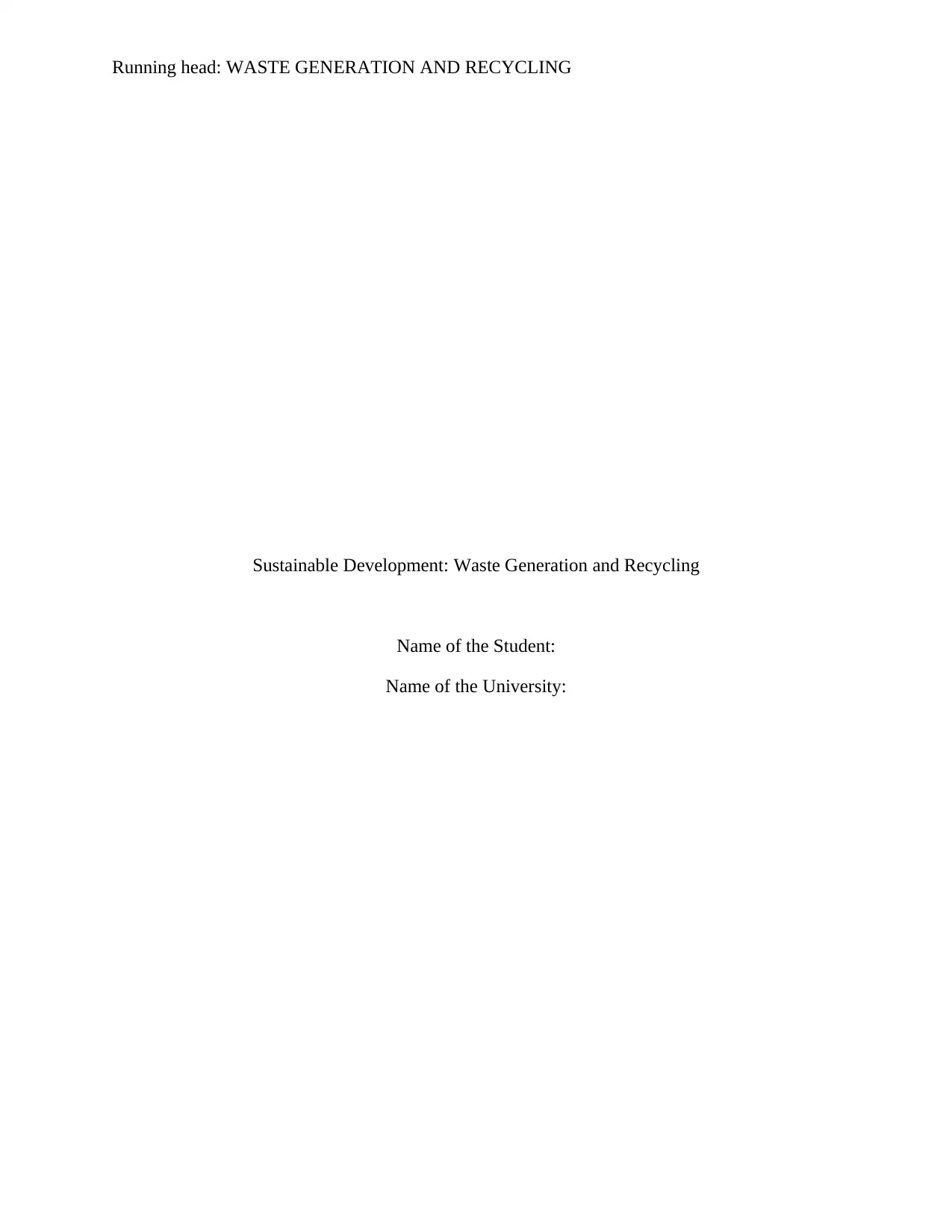
Running head: WASTE GENERATION AND RECYCLING
Sustainable Development: Waste Generation and Recycling
Name of the Student:
Name of the University:
Sustainable Development: Waste Generation and Recycling
Name of the Student:
Name of the University:
Paraphrase This Document
Need a fresh take? Get an instant paraphrase of this document with our AI Paraphraser
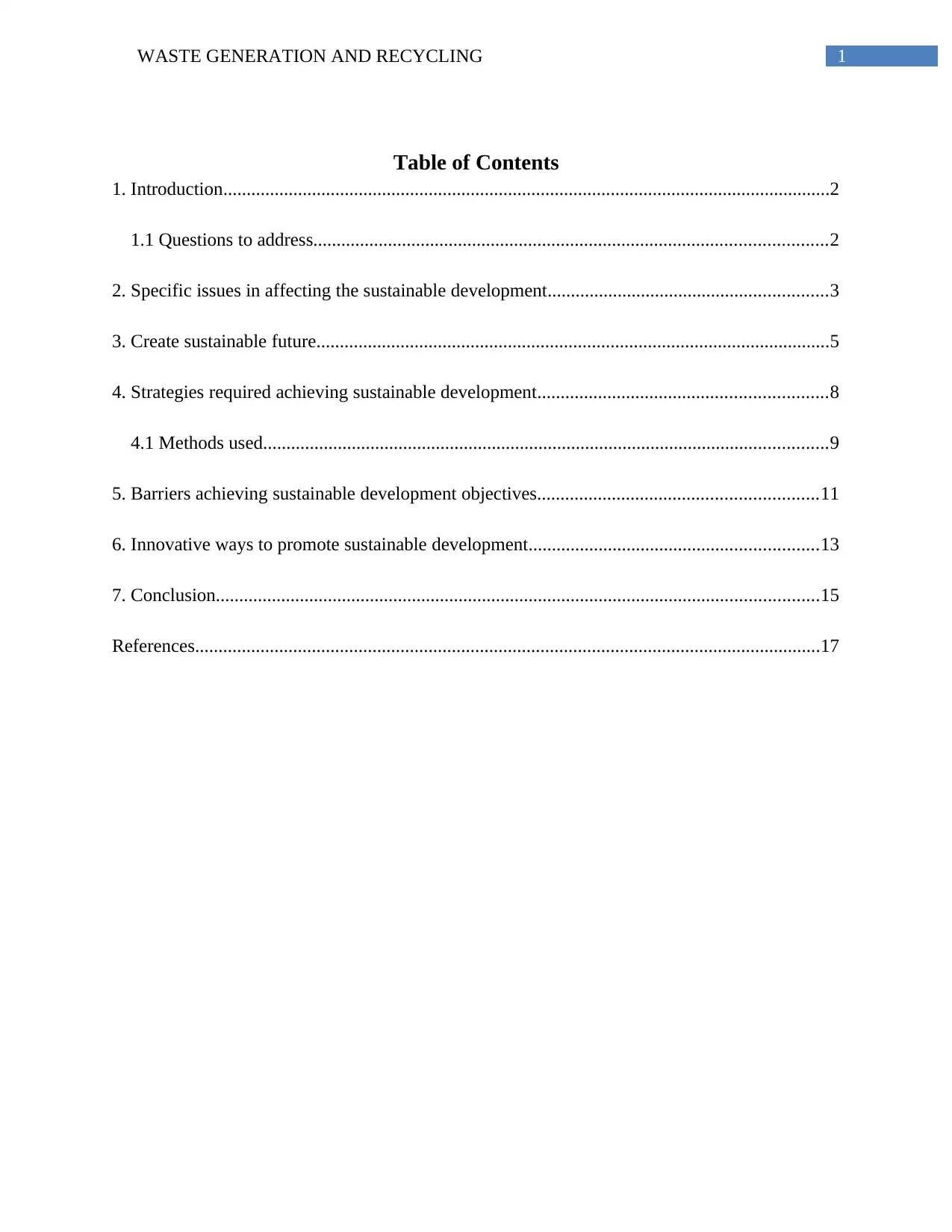
1WASTE GENERATION AND RECYCLING
Table of Contents
1. Introduction..................................................................................................................................2
1.1 Questions to address..............................................................................................................2
2. Specific issues in affecting the sustainable development............................................................3
3. Create sustainable future..............................................................................................................5
4. Strategies required achieving sustainable development..............................................................8
4.1 Methods used.........................................................................................................................9
5. Barriers achieving sustainable development objectives............................................................11
6. Innovative ways to promote sustainable development..............................................................13
7. Conclusion.................................................................................................................................15
References......................................................................................................................................17
Table of Contents
1. Introduction..................................................................................................................................2
1.1 Questions to address..............................................................................................................2
2. Specific issues in affecting the sustainable development............................................................3
3. Create sustainable future..............................................................................................................5
4. Strategies required achieving sustainable development..............................................................8
4.1 Methods used.........................................................................................................................9
5. Barriers achieving sustainable development objectives............................................................11
6. Innovative ways to promote sustainable development..............................................................13
7. Conclusion.................................................................................................................................15
References......................................................................................................................................17
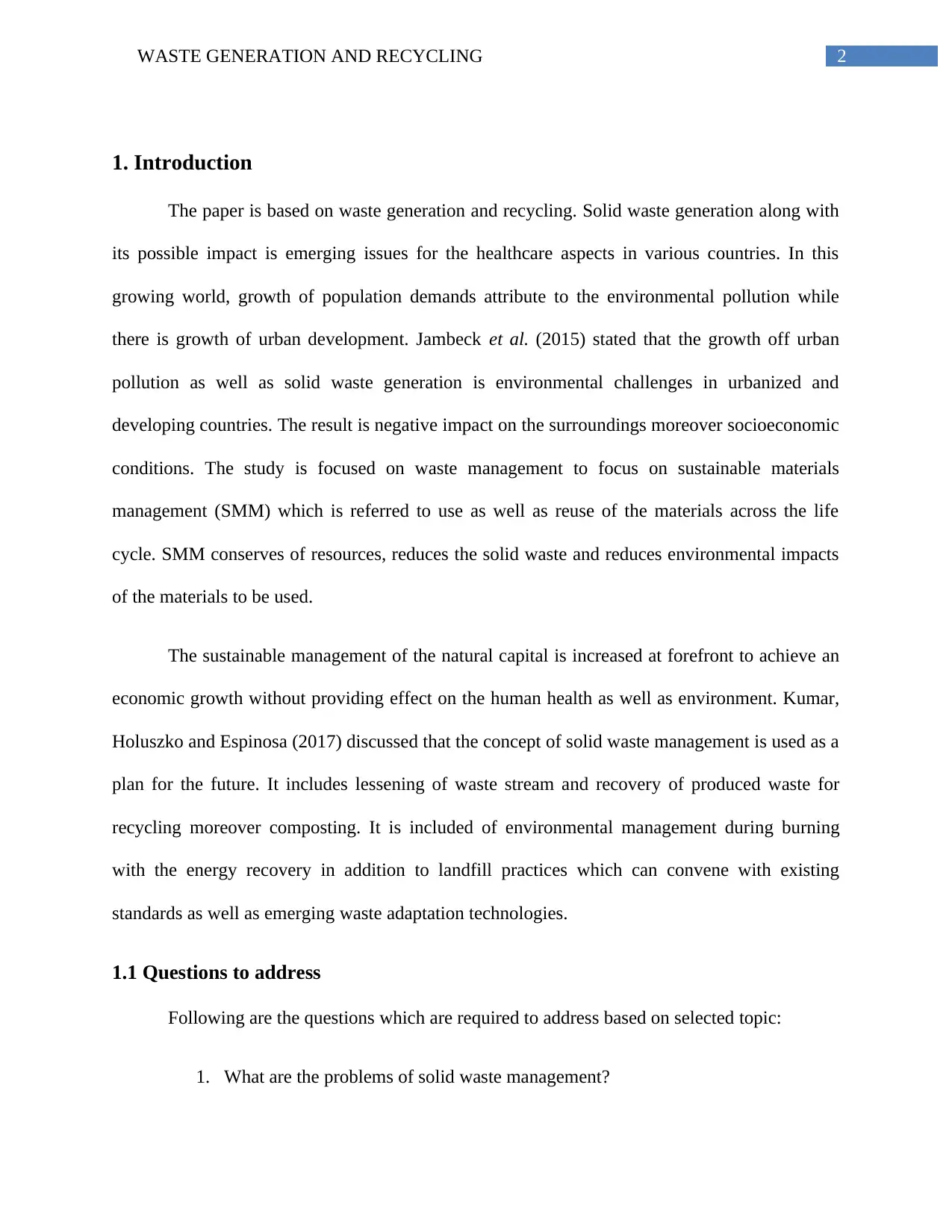
2WASTE GENERATION AND RECYCLING
1. Introduction
The paper is based on waste generation and recycling. Solid waste generation along with
its possible impact is emerging issues for the healthcare aspects in various countries. In this
growing world, growth of population demands attribute to the environmental pollution while
there is growth of urban development. Jambeck et al. (2015) stated that the growth off urban
pollution as well as solid waste generation is environmental challenges in urbanized and
developing countries. The result is negative impact on the surroundings moreover socioeconomic
conditions. The study is focused on waste management to focus on sustainable materials
management (SMM) which is referred to use as well as reuse of the materials across the life
cycle. SMM conserves of resources, reduces the solid waste and reduces environmental impacts
of the materials to be used.
The sustainable management of the natural capital is increased at forefront to achieve an
economic growth without providing effect on the human health as well as environment. Kumar,
Holuszko and Espinosa (2017) discussed that the concept of solid waste management is used as a
plan for the future. It includes lessening of waste stream and recovery of produced waste for
recycling moreover composting. It is included of environmental management during burning
with the energy recovery in addition to landfill practices which can convene with existing
standards as well as emerging waste adaptation technologies.
1.1 Questions to address
Following are the questions which are required to address based on selected topic:
1. What are the problems of solid waste management?
1. Introduction
The paper is based on waste generation and recycling. Solid waste generation along with
its possible impact is emerging issues for the healthcare aspects in various countries. In this
growing world, growth of population demands attribute to the environmental pollution while
there is growth of urban development. Jambeck et al. (2015) stated that the growth off urban
pollution as well as solid waste generation is environmental challenges in urbanized and
developing countries. The result is negative impact on the surroundings moreover socioeconomic
conditions. The study is focused on waste management to focus on sustainable materials
management (SMM) which is referred to use as well as reuse of the materials across the life
cycle. SMM conserves of resources, reduces the solid waste and reduces environmental impacts
of the materials to be used.
The sustainable management of the natural capital is increased at forefront to achieve an
economic growth without providing effect on the human health as well as environment. Kumar,
Holuszko and Espinosa (2017) discussed that the concept of solid waste management is used as a
plan for the future. It includes lessening of waste stream and recovery of produced waste for
recycling moreover composting. It is included of environmental management during burning
with the energy recovery in addition to landfill practices which can convene with existing
standards as well as emerging waste adaptation technologies.
1.1 Questions to address
Following are the questions which are required to address based on selected topic:
1. What are the problems of solid waste management?
⊘ This is a preview!⊘
Do you want full access?
Subscribe today to unlock all pages.

Trusted by 1+ million students worldwide
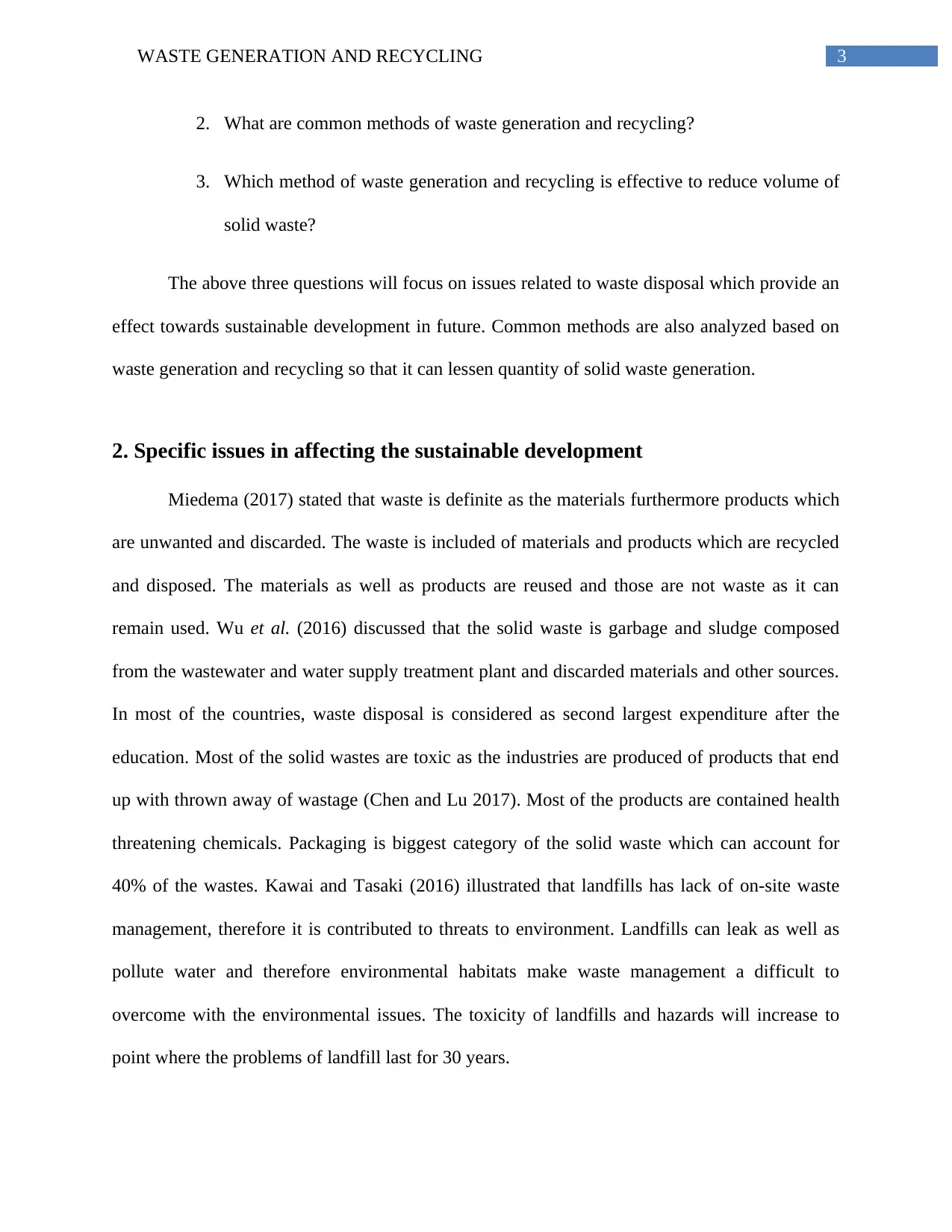
3WASTE GENERATION AND RECYCLING
2. What are common methods of waste generation and recycling?
3. Which method of waste generation and recycling is effective to reduce volume of
solid waste?
The above three questions will focus on issues related to waste disposal which provide an
effect towards sustainable development in future. Common methods are also analyzed based on
waste generation and recycling so that it can lessen quantity of solid waste generation.
2. Specific issues in affecting the sustainable development
Miedema (2017) stated that waste is definite as the materials furthermore products which
are unwanted and discarded. The waste is included of materials and products which are recycled
and disposed. The materials as well as products are reused and those are not waste as it can
remain used. Wu et al. (2016) discussed that the solid waste is garbage and sludge composed
from the wastewater and water supply treatment plant and discarded materials and other sources.
In most of the countries, waste disposal is considered as second largest expenditure after the
education. Most of the solid wastes are toxic as the industries are produced of products that end
up with thrown away of wastage (Chen and Lu 2017). Most of the products are contained health
threatening chemicals. Packaging is biggest category of the solid waste which can account for
40% of the wastes. Kawai and Tasaki (2016) illustrated that landfills has lack of on-site waste
management, therefore it is contributed to threats to environment. Landfills can leak as well as
pollute water and therefore environmental habitats make waste management a difficult to
overcome with the environmental issues. The toxicity of landfills and hazards will increase to
point where the problems of landfill last for 30 years.
2. What are common methods of waste generation and recycling?
3. Which method of waste generation and recycling is effective to reduce volume of
solid waste?
The above three questions will focus on issues related to waste disposal which provide an
effect towards sustainable development in future. Common methods are also analyzed based on
waste generation and recycling so that it can lessen quantity of solid waste generation.
2. Specific issues in affecting the sustainable development
Miedema (2017) stated that waste is definite as the materials furthermore products which
are unwanted and discarded. The waste is included of materials and products which are recycled
and disposed. The materials as well as products are reused and those are not waste as it can
remain used. Wu et al. (2016) discussed that the solid waste is garbage and sludge composed
from the wastewater and water supply treatment plant and discarded materials and other sources.
In most of the countries, waste disposal is considered as second largest expenditure after the
education. Most of the solid wastes are toxic as the industries are produced of products that end
up with thrown away of wastage (Chen and Lu 2017). Most of the products are contained health
threatening chemicals. Packaging is biggest category of the solid waste which can account for
40% of the wastes. Kawai and Tasaki (2016) illustrated that landfills has lack of on-site waste
management, therefore it is contributed to threats to environment. Landfills can leak as well as
pollute water and therefore environmental habitats make waste management a difficult to
overcome with the environmental issues. The toxicity of landfills and hazards will increase to
point where the problems of landfill last for 30 years.
Paraphrase This Document
Need a fresh take? Get an instant paraphrase of this document with our AI Paraphraser

4WASTE GENERATION AND RECYCLING
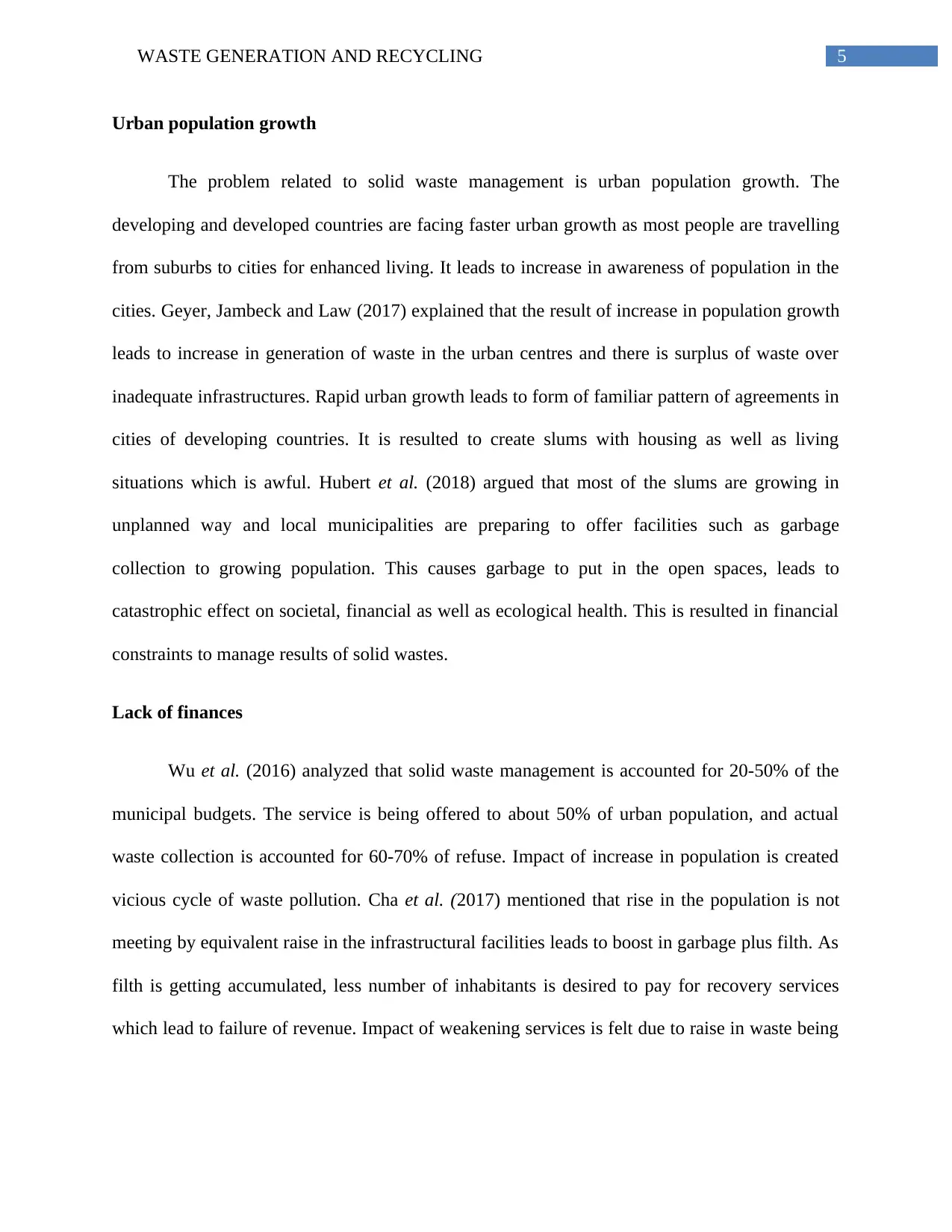
5WASTE GENERATION AND RECYCLING
Urban population growth
The problem related to solid waste management is urban population growth. The
developing and developed countries are facing faster urban growth as most people are travelling
from suburbs to cities for enhanced living. It leads to increase in awareness of population in the
cities. Geyer, Jambeck and Law (2017) explained that the result of increase in population growth
leads to increase in generation of waste in the urban centres and there is surplus of waste over
inadequate infrastructures. Rapid urban growth leads to form of familiar pattern of agreements in
cities of developing countries. It is resulted to create slums with housing as well as living
situations which is awful. Hubert et al. (2018) argued that most of the slums are growing in
unplanned way and local municipalities are preparing to offer facilities such as garbage
collection to growing population. This causes garbage to put in the open spaces, leads to
catastrophic effect on societal, financial as well as ecological health. This is resulted in financial
constraints to manage results of solid wastes.
Lack of finances
Wu et al. (2016) analyzed that solid waste management is accounted for 20-50% of the
municipal budgets. The service is being offered to about 50% of urban population, and actual
waste collection is accounted for 60-70% of refuse. Impact of increase in population is created
vicious cycle of waste pollution. Cha et al. (2017) mentioned that rise in the population is not
meeting by equivalent raise in the infrastructural facilities leads to boost in garbage plus filth. As
filth is getting accumulated, less number of inhabitants is desired to pay for recovery services
which lead to failure of revenue. Impact of weakening services is felt due to raise in waste being
Urban population growth
The problem related to solid waste management is urban population growth. The
developing and developed countries are facing faster urban growth as most people are travelling
from suburbs to cities for enhanced living. It leads to increase in awareness of population in the
cities. Geyer, Jambeck and Law (2017) explained that the result of increase in population growth
leads to increase in generation of waste in the urban centres and there is surplus of waste over
inadequate infrastructures. Rapid urban growth leads to form of familiar pattern of agreements in
cities of developing countries. It is resulted to create slums with housing as well as living
situations which is awful. Hubert et al. (2018) argued that most of the slums are growing in
unplanned way and local municipalities are preparing to offer facilities such as garbage
collection to growing population. This causes garbage to put in the open spaces, leads to
catastrophic effect on societal, financial as well as ecological health. This is resulted in financial
constraints to manage results of solid wastes.
Lack of finances
Wu et al. (2016) analyzed that solid waste management is accounted for 20-50% of the
municipal budgets. The service is being offered to about 50% of urban population, and actual
waste collection is accounted for 60-70% of refuse. Impact of increase in population is created
vicious cycle of waste pollution. Cha et al. (2017) mentioned that rise in the population is not
meeting by equivalent raise in the infrastructural facilities leads to boost in garbage plus filth. As
filth is getting accumulated, less number of inhabitants is desired to pay for recovery services
which lead to failure of revenue. Impact of weakening services is felt due to raise in waste being
⊘ This is a preview!⊘
Do you want full access?
Subscribe today to unlock all pages.

Trusted by 1+ million students worldwide
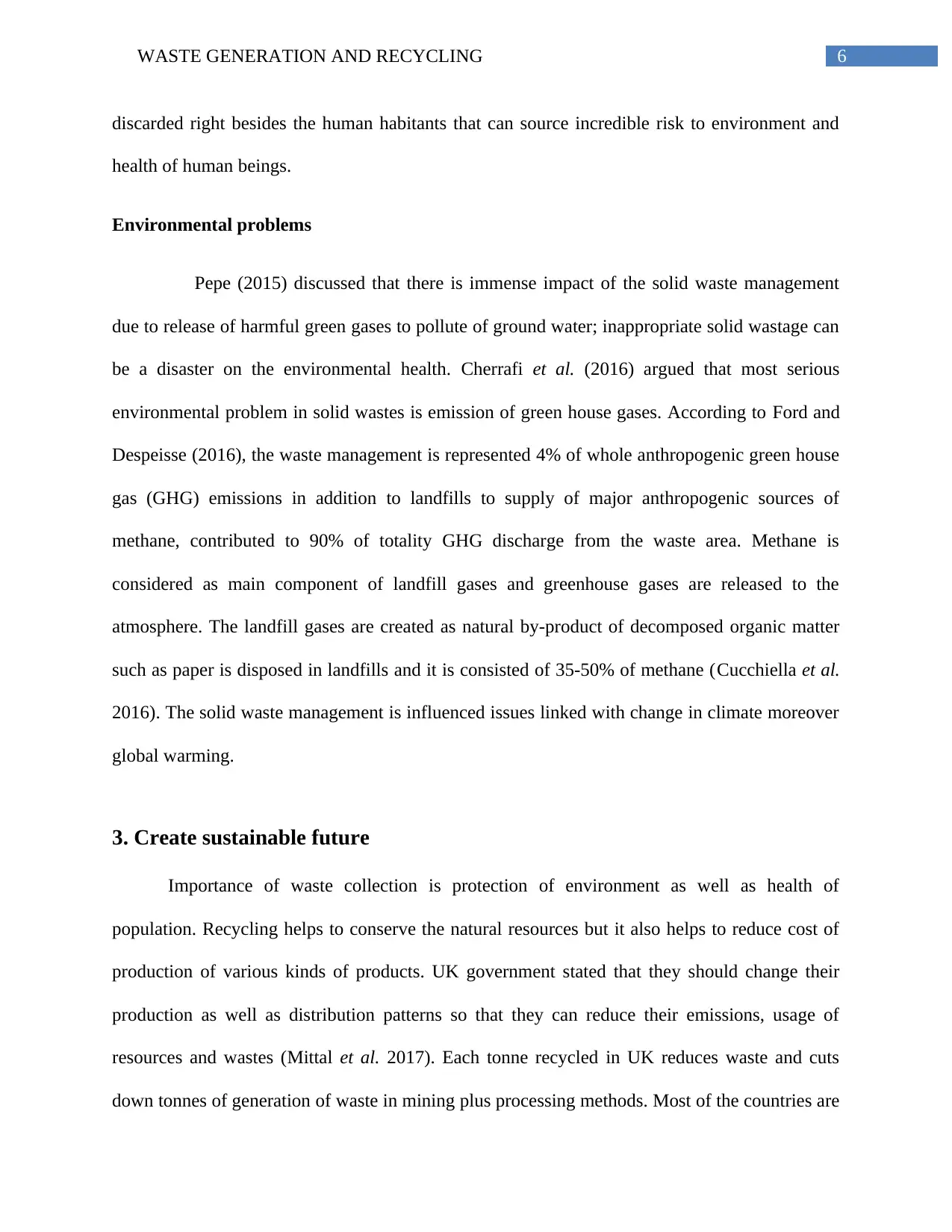
6WASTE GENERATION AND RECYCLING
discarded right besides the human habitants that can source incredible risk to environment and
health of human beings.
Environmental problems
Pepe (2015) discussed that there is immense impact of the solid waste management
due to release of harmful green gases to pollute of ground water; inappropriate solid wastage can
be a disaster on the environmental health. Cherrafi et al. (2016) argued that most serious
environmental problem in solid wastes is emission of green house gases. According to Ford and
Despeisse (2016), the waste management is represented 4% of whole anthropogenic green house
gas (GHG) emissions in addition to landfills to supply of major anthropogenic sources of
methane, contributed to 90% of totality GHG discharge from the waste area. Methane is
considered as main component of landfill gases and greenhouse gases are released to the
atmosphere. The landfill gases are created as natural by-product of decomposed organic matter
such as paper is disposed in landfills and it is consisted of 35-50% of methane (Cucchiella et al.
2016). The solid waste management is influenced issues linked with change in climate moreover
global warming.
3. Create sustainable future
Importance of waste collection is protection of environment as well as health of
population. Recycling helps to conserve the natural resources but it also helps to reduce cost of
production of various kinds of products. UK government stated that they should change their
production as well as distribution patterns so that they can reduce their emissions, usage of
resources and wastes (Mittal et al. 2017). Each tonne recycled in UK reduces waste and cuts
down tonnes of generation of waste in mining plus processing methods. Most of the countries are
discarded right besides the human habitants that can source incredible risk to environment and
health of human beings.
Environmental problems
Pepe (2015) discussed that there is immense impact of the solid waste management
due to release of harmful green gases to pollute of ground water; inappropriate solid wastage can
be a disaster on the environmental health. Cherrafi et al. (2016) argued that most serious
environmental problem in solid wastes is emission of green house gases. According to Ford and
Despeisse (2016), the waste management is represented 4% of whole anthropogenic green house
gas (GHG) emissions in addition to landfills to supply of major anthropogenic sources of
methane, contributed to 90% of totality GHG discharge from the waste area. Methane is
considered as main component of landfill gases and greenhouse gases are released to the
atmosphere. The landfill gases are created as natural by-product of decomposed organic matter
such as paper is disposed in landfills and it is consisted of 35-50% of methane (Cucchiella et al.
2016). The solid waste management is influenced issues linked with change in climate moreover
global warming.
3. Create sustainable future
Importance of waste collection is protection of environment as well as health of
population. Recycling helps to conserve the natural resources but it also helps to reduce cost of
production of various kinds of products. UK government stated that they should change their
production as well as distribution patterns so that they can reduce their emissions, usage of
resources and wastes (Mittal et al. 2017). Each tonne recycled in UK reduces waste and cuts
down tonnes of generation of waste in mining plus processing methods. Most of the countries are
Paraphrase This Document
Need a fresh take? Get an instant paraphrase of this document with our AI Paraphraser
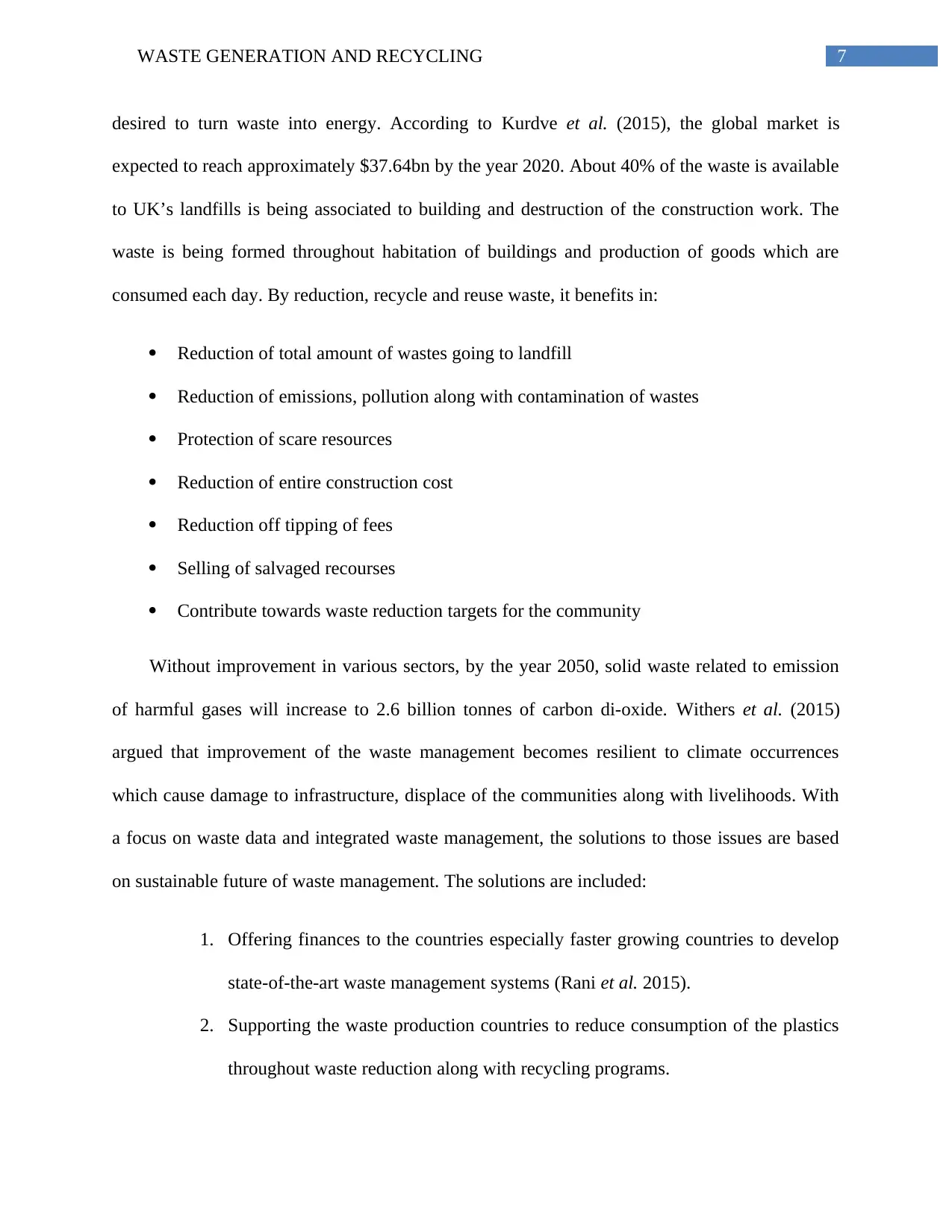
7WASTE GENERATION AND RECYCLING
desired to turn waste into energy. According to Kurdve et al. (2015), the global market is
expected to reach approximately $37.64bn by the year 2020. About 40% of the waste is available
to UK’s landfills is being associated to building and destruction of the construction work. The
waste is being formed throughout habitation of buildings and production of goods which are
consumed each day. By reduction, recycle and reuse waste, it benefits in:
Reduction of total amount of wastes going to landfill
Reduction of emissions, pollution along with contamination of wastes
Protection of scare resources
Reduction of entire construction cost
Reduction off tipping of fees
Selling of salvaged recourses
Contribute towards waste reduction targets for the community
Without improvement in various sectors, by the year 2050, solid waste related to emission
of harmful gases will increase to 2.6 billion tonnes of carbon di-oxide. Withers et al. (2015)
argued that improvement of the waste management becomes resilient to climate occurrences
which cause damage to infrastructure, displace of the communities along with livelihoods. With
a focus on waste data and integrated waste management, the solutions to those issues are based
on sustainable future of waste management. The solutions are included:
1. Offering finances to the countries especially faster growing countries to develop
state-of-the-art waste management systems (Rani et al. 2015).
2. Supporting the waste production countries to reduce consumption of the plastics
throughout waste reduction along with recycling programs.
desired to turn waste into energy. According to Kurdve et al. (2015), the global market is
expected to reach approximately $37.64bn by the year 2020. About 40% of the waste is available
to UK’s landfills is being associated to building and destruction of the construction work. The
waste is being formed throughout habitation of buildings and production of goods which are
consumed each day. By reduction, recycle and reuse waste, it benefits in:
Reduction of total amount of wastes going to landfill
Reduction of emissions, pollution along with contamination of wastes
Protection of scare resources
Reduction of entire construction cost
Reduction off tipping of fees
Selling of salvaged recourses
Contribute towards waste reduction targets for the community
Without improvement in various sectors, by the year 2050, solid waste related to emission
of harmful gases will increase to 2.6 billion tonnes of carbon di-oxide. Withers et al. (2015)
argued that improvement of the waste management becomes resilient to climate occurrences
which cause damage to infrastructure, displace of the communities along with livelihoods. With
a focus on waste data and integrated waste management, the solutions to those issues are based
on sustainable future of waste management. The solutions are included:
1. Offering finances to the countries especially faster growing countries to develop
state-of-the-art waste management systems (Rani et al. 2015).
2. Supporting the waste production countries to reduce consumption of the plastics
throughout waste reduction along with recycling programs.
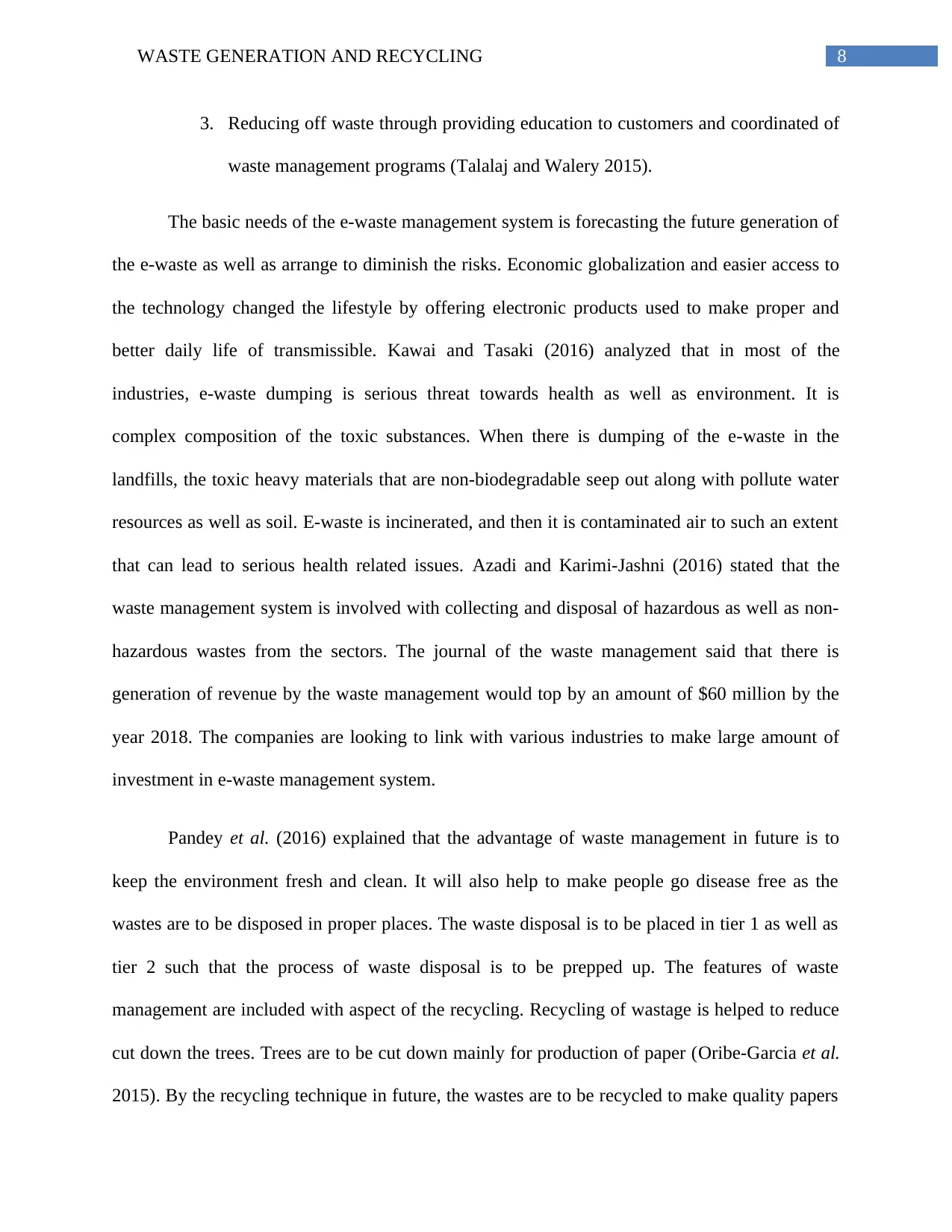
8WASTE GENERATION AND RECYCLING
3. Reducing off waste through providing education to customers and coordinated of
waste management programs (Talalaj and Walery 2015).
The basic needs of the e-waste management system is forecasting the future generation of
the e-waste as well as arrange to diminish the risks. Economic globalization and easier access to
the technology changed the lifestyle by offering electronic products used to make proper and
better daily life of transmissible. Kawai and Tasaki (2016) analyzed that in most of the
industries, e-waste dumping is serious threat towards health as well as environment. It is
complex composition of the toxic substances. When there is dumping of the e-waste in the
landfills, the toxic heavy materials that are non-biodegradable seep out along with pollute water
resources as well as soil. E-waste is incinerated, and then it is contaminated air to such an extent
that can lead to serious health related issues. Azadi and Karimi-Jashni (2016) stated that the
waste management system is involved with collecting and disposal of hazardous as well as non-
hazardous wastes from the sectors. The journal of the waste management said that there is
generation of revenue by the waste management would top by an amount of $60 million by the
year 2018. The companies are looking to link with various industries to make large amount of
investment in e-waste management system.
Pandey et al. (2016) explained that the advantage of waste management in future is to
keep the environment fresh and clean. It will also help to make people go disease free as the
wastes are to be disposed in proper places. The waste disposal is to be placed in tier 1 as well as
tier 2 such that the process of waste disposal is to be prepped up. The features of waste
management are included with aspect of the recycling. Recycling of wastage is helped to reduce
cut down the trees. Trees are to be cut down mainly for production of paper (Oribe-Garcia et al.
2015). By the recycling technique in future, the wastes are to be recycled to make quality papers
3. Reducing off waste through providing education to customers and coordinated of
waste management programs (Talalaj and Walery 2015).
The basic needs of the e-waste management system is forecasting the future generation of
the e-waste as well as arrange to diminish the risks. Economic globalization and easier access to
the technology changed the lifestyle by offering electronic products used to make proper and
better daily life of transmissible. Kawai and Tasaki (2016) analyzed that in most of the
industries, e-waste dumping is serious threat towards health as well as environment. It is
complex composition of the toxic substances. When there is dumping of the e-waste in the
landfills, the toxic heavy materials that are non-biodegradable seep out along with pollute water
resources as well as soil. E-waste is incinerated, and then it is contaminated air to such an extent
that can lead to serious health related issues. Azadi and Karimi-Jashni (2016) stated that the
waste management system is involved with collecting and disposal of hazardous as well as non-
hazardous wastes from the sectors. The journal of the waste management said that there is
generation of revenue by the waste management would top by an amount of $60 million by the
year 2018. The companies are looking to link with various industries to make large amount of
investment in e-waste management system.
Pandey et al. (2016) explained that the advantage of waste management in future is to
keep the environment fresh and clean. It will also help to make people go disease free as the
wastes are to be disposed in proper places. The waste disposal is to be placed in tier 1 as well as
tier 2 such that the process of waste disposal is to be prepped up. The features of waste
management are included with aspect of the recycling. Recycling of wastage is helped to reduce
cut down the trees. Trees are to be cut down mainly for production of paper (Oribe-Garcia et al.
2015). By the recycling technique in future, the wastes are to be recycled to make quality papers
⊘ This is a preview!⊘
Do you want full access?
Subscribe today to unlock all pages.

Trusted by 1+ million students worldwide
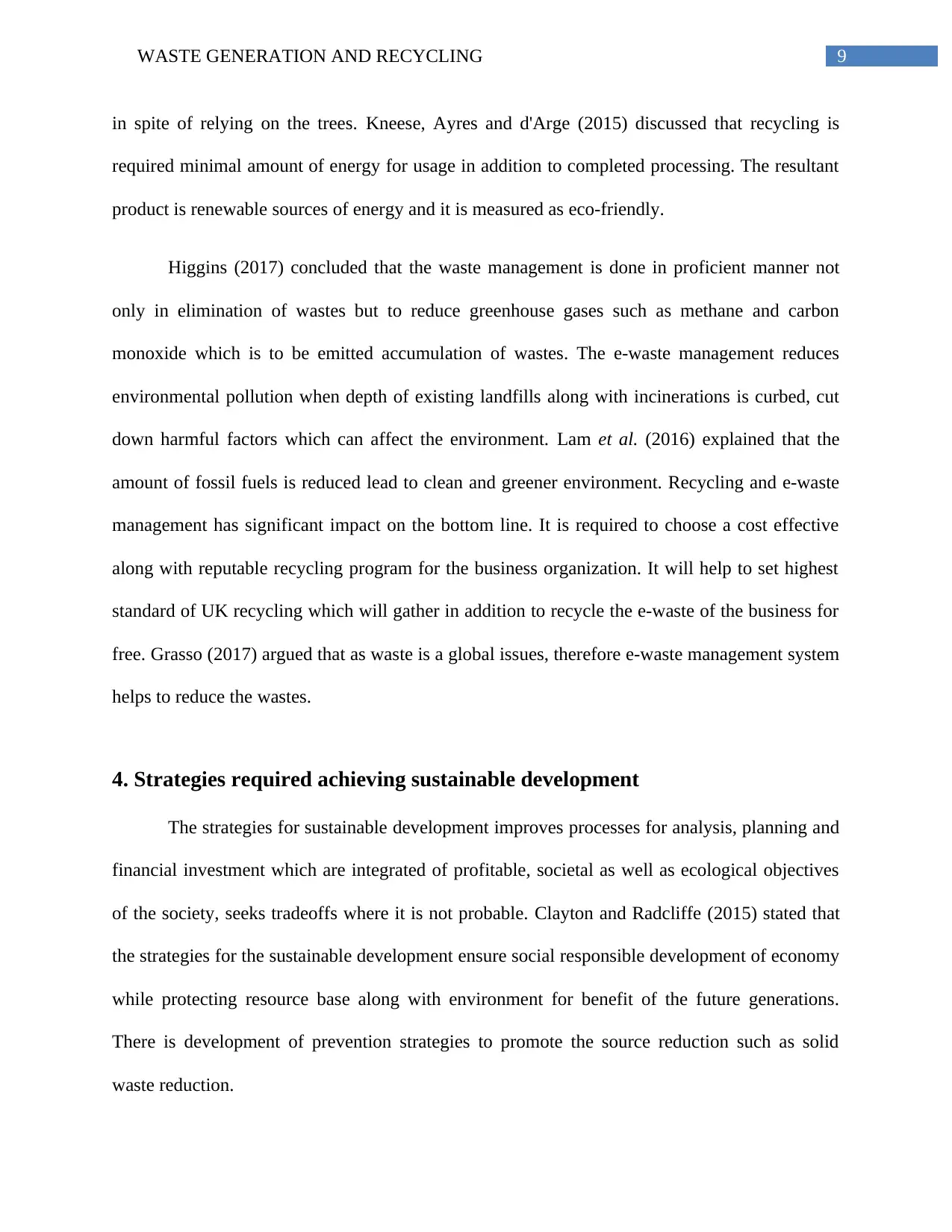
9WASTE GENERATION AND RECYCLING
in spite of relying on the trees. Kneese, Ayres and d'Arge (2015) discussed that recycling is
required minimal amount of energy for usage in addition to completed processing. The resultant
product is renewable sources of energy and it is measured as eco-friendly.
Higgins (2017) concluded that the waste management is done in proficient manner not
only in elimination of wastes but to reduce greenhouse gases such as methane and carbon
monoxide which is to be emitted accumulation of wastes. The e-waste management reduces
environmental pollution when depth of existing landfills along with incinerations is curbed, cut
down harmful factors which can affect the environment. Lam et al. (2016) explained that the
amount of fossil fuels is reduced lead to clean and greener environment. Recycling and e-waste
management has significant impact on the bottom line. It is required to choose a cost effective
along with reputable recycling program for the business organization. It will help to set highest
standard of UK recycling which will gather in addition to recycle the e-waste of the business for
free. Grasso (2017) argued that as waste is a global issues, therefore e-waste management system
helps to reduce the wastes.
4. Strategies required achieving sustainable development
The strategies for sustainable development improves processes for analysis, planning and
financial investment which are integrated of profitable, societal as well as ecological objectives
of the society, seeks tradeoffs where it is not probable. Clayton and Radcliffe (2015) stated that
the strategies for the sustainable development ensure social responsible development of economy
while protecting resource base along with environment for benefit of the future generations.
There is development of prevention strategies to promote the source reduction such as solid
waste reduction.
in spite of relying on the trees. Kneese, Ayres and d'Arge (2015) discussed that recycling is
required minimal amount of energy for usage in addition to completed processing. The resultant
product is renewable sources of energy and it is measured as eco-friendly.
Higgins (2017) concluded that the waste management is done in proficient manner not
only in elimination of wastes but to reduce greenhouse gases such as methane and carbon
monoxide which is to be emitted accumulation of wastes. The e-waste management reduces
environmental pollution when depth of existing landfills along with incinerations is curbed, cut
down harmful factors which can affect the environment. Lam et al. (2016) explained that the
amount of fossil fuels is reduced lead to clean and greener environment. Recycling and e-waste
management has significant impact on the bottom line. It is required to choose a cost effective
along with reputable recycling program for the business organization. It will help to set highest
standard of UK recycling which will gather in addition to recycle the e-waste of the business for
free. Grasso (2017) argued that as waste is a global issues, therefore e-waste management system
helps to reduce the wastes.
4. Strategies required achieving sustainable development
The strategies for sustainable development improves processes for analysis, planning and
financial investment which are integrated of profitable, societal as well as ecological objectives
of the society, seeks tradeoffs where it is not probable. Clayton and Radcliffe (2015) stated that
the strategies for the sustainable development ensure social responsible development of economy
while protecting resource base along with environment for benefit of the future generations.
There is development of prevention strategies to promote the source reduction such as solid
waste reduction.
Paraphrase This Document
Need a fresh take? Get an instant paraphrase of this document with our AI Paraphraser
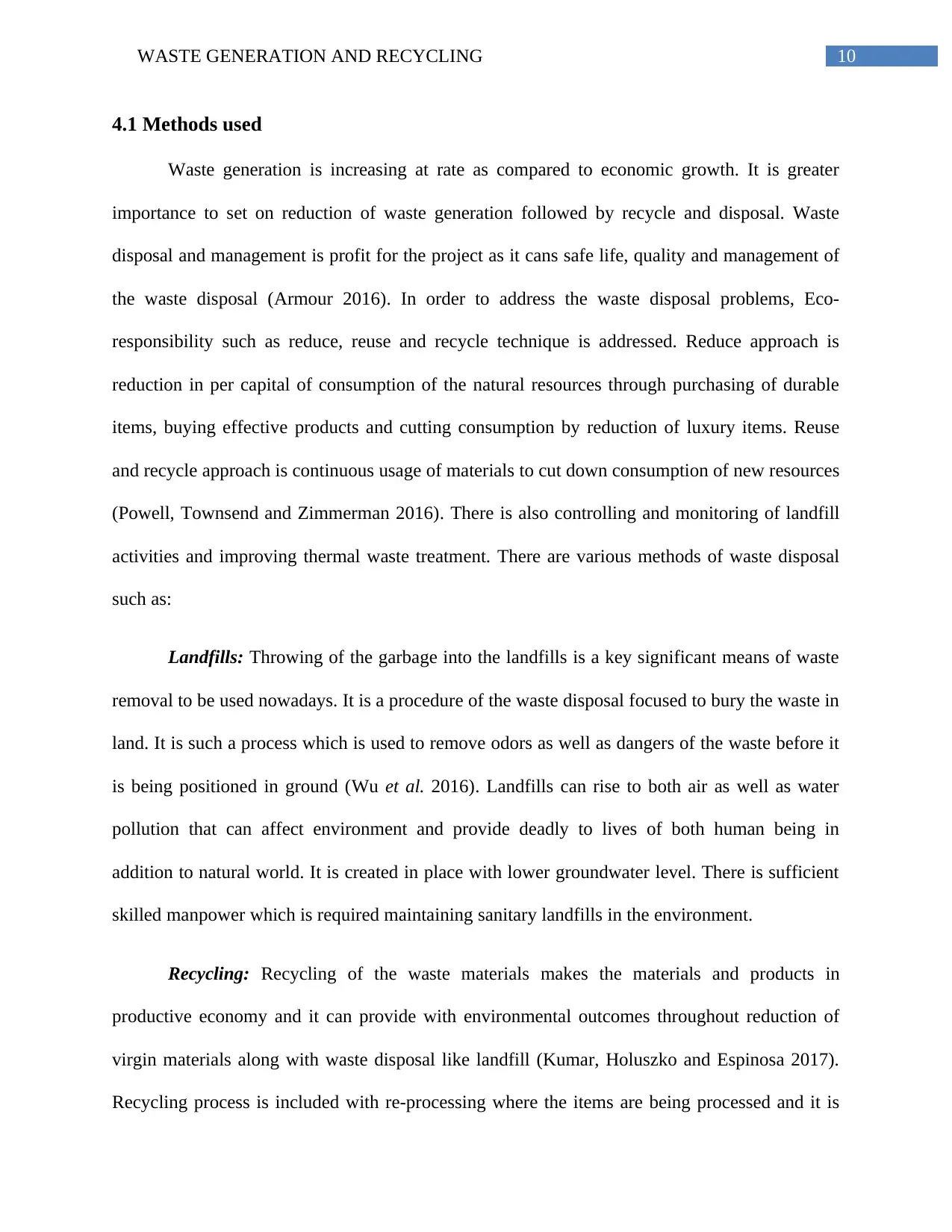
10WASTE GENERATION AND RECYCLING
4.1 Methods used
Waste generation is increasing at rate as compared to economic growth. It is greater
importance to set on reduction of waste generation followed by recycle and disposal. Waste
disposal and management is profit for the project as it cans safe life, quality and management of
the waste disposal (Armour 2016). In order to address the waste disposal problems, Eco-
responsibility such as reduce, reuse and recycle technique is addressed. Reduce approach is
reduction in per capital of consumption of the natural resources through purchasing of durable
items, buying effective products and cutting consumption by reduction of luxury items. Reuse
and recycle approach is continuous usage of materials to cut down consumption of new resources
(Powell, Townsend and Zimmerman 2016). There is also controlling and monitoring of landfill
activities and improving thermal waste treatment. There are various methods of waste disposal
such as:
Landfills: Throwing of the garbage into the landfills is a key significant means of waste
removal to be used nowadays. It is a procedure of the waste disposal focused to bury the waste in
land. It is such a process which is used to remove odors as well as dangers of the waste before it
is being positioned in ground (Wu et al. 2016). Landfills can rise to both air as well as water
pollution that can affect environment and provide deadly to lives of both human being in
addition to natural world. It is created in place with lower groundwater level. There is sufficient
skilled manpower which is required maintaining sanitary landfills in the environment.
Recycling: Recycling of the waste materials makes the materials and products in
productive economy and it can provide with environmental outcomes throughout reduction of
virgin materials along with waste disposal like landfill (Kumar, Holuszko and Espinosa 2017).
Recycling process is included with re-processing where the items are being processed and it is
4.1 Methods used
Waste generation is increasing at rate as compared to economic growth. It is greater
importance to set on reduction of waste generation followed by recycle and disposal. Waste
disposal and management is profit for the project as it cans safe life, quality and management of
the waste disposal (Armour 2016). In order to address the waste disposal problems, Eco-
responsibility such as reduce, reuse and recycle technique is addressed. Reduce approach is
reduction in per capital of consumption of the natural resources through purchasing of durable
items, buying effective products and cutting consumption by reduction of luxury items. Reuse
and recycle approach is continuous usage of materials to cut down consumption of new resources
(Powell, Townsend and Zimmerman 2016). There is also controlling and monitoring of landfill
activities and improving thermal waste treatment. There are various methods of waste disposal
such as:
Landfills: Throwing of the garbage into the landfills is a key significant means of waste
removal to be used nowadays. It is a procedure of the waste disposal focused to bury the waste in
land. It is such a process which is used to remove odors as well as dangers of the waste before it
is being positioned in ground (Wu et al. 2016). Landfills can rise to both air as well as water
pollution that can affect environment and provide deadly to lives of both human being in
addition to natural world. It is created in place with lower groundwater level. There is sufficient
skilled manpower which is required maintaining sanitary landfills in the environment.
Recycling: Recycling of the waste materials makes the materials and products in
productive economy and it can provide with environmental outcomes throughout reduction of
virgin materials along with waste disposal like landfill (Kumar, Holuszko and Espinosa 2017).
Recycling process is included with re-processing where the items are being processed and it is
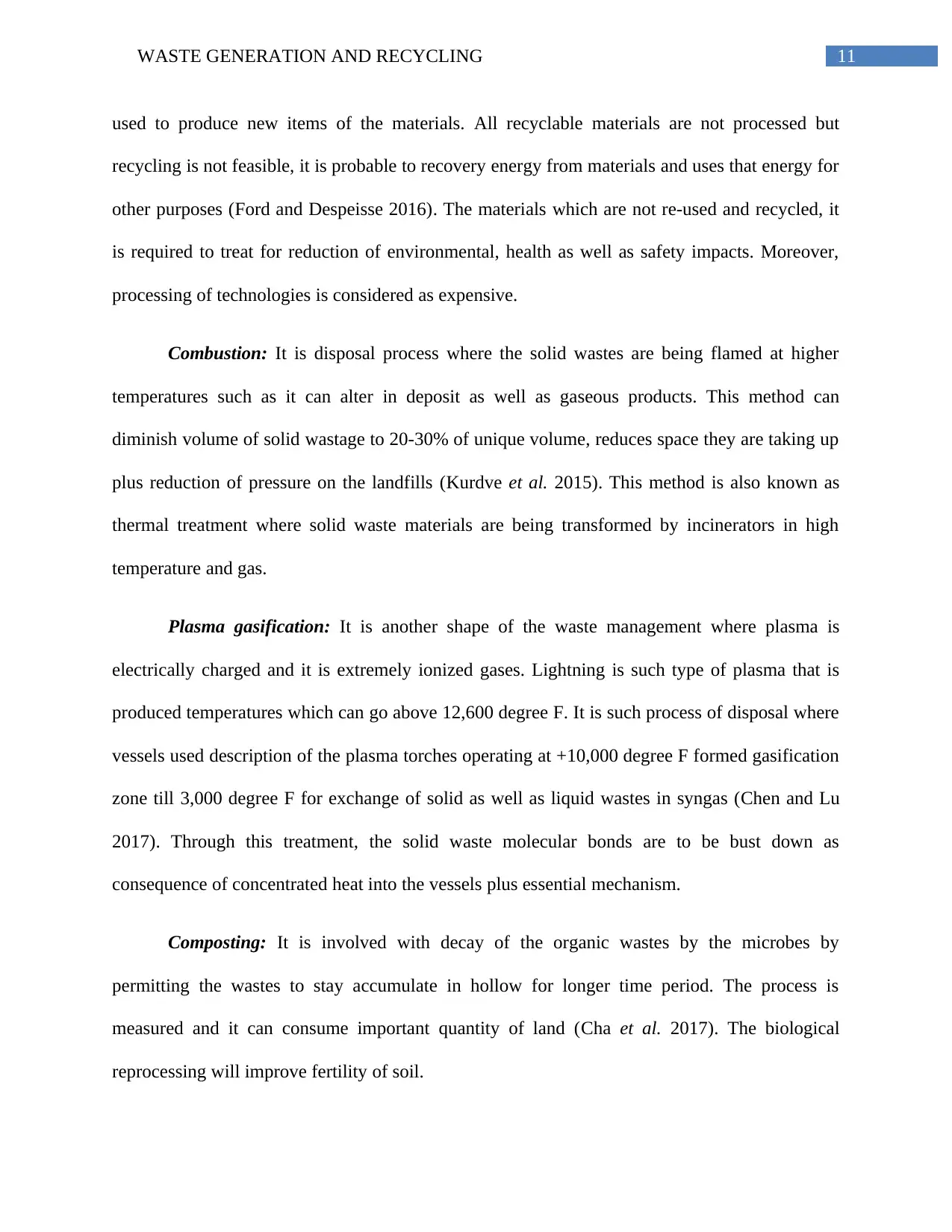
11WASTE GENERATION AND RECYCLING
used to produce new items of the materials. All recyclable materials are not processed but
recycling is not feasible, it is probable to recovery energy from materials and uses that energy for
other purposes (Ford and Despeisse 2016). The materials which are not re-used and recycled, it
is required to treat for reduction of environmental, health as well as safety impacts. Moreover,
processing of technologies is considered as expensive.
Combustion: It is disposal process where the solid wastes are being flamed at higher
temperatures such as it can alter in deposit as well as gaseous products. This method can
diminish volume of solid wastage to 20-30% of unique volume, reduces space they are taking up
plus reduction of pressure on the landfills (Kurdve et al. 2015). This method is also known as
thermal treatment where solid waste materials are being transformed by incinerators in high
temperature and gas.
Plasma gasification: It is another shape of the waste management where plasma is
electrically charged and it is extremely ionized gases. Lightning is such type of plasma that is
produced temperatures which can go above 12,600 degree F. It is such process of disposal where
vessels used description of the plasma torches operating at +10,000 degree F formed gasification
zone till 3,000 degree F for exchange of solid as well as liquid wastes in syngas (Chen and Lu
2017). Through this treatment, the solid waste molecular bonds are to be bust down as
consequence of concentrated heat into the vessels plus essential mechanism.
Composting: It is involved with decay of the organic wastes by the microbes by
permitting the wastes to stay accumulate in hollow for longer time period. The process is
measured and it can consume important quantity of land (Cha et al. 2017). The biological
reprocessing will improve fertility of soil.
used to produce new items of the materials. All recyclable materials are not processed but
recycling is not feasible, it is probable to recovery energy from materials and uses that energy for
other purposes (Ford and Despeisse 2016). The materials which are not re-used and recycled, it
is required to treat for reduction of environmental, health as well as safety impacts. Moreover,
processing of technologies is considered as expensive.
Combustion: It is disposal process where the solid wastes are being flamed at higher
temperatures such as it can alter in deposit as well as gaseous products. This method can
diminish volume of solid wastage to 20-30% of unique volume, reduces space they are taking up
plus reduction of pressure on the landfills (Kurdve et al. 2015). This method is also known as
thermal treatment where solid waste materials are being transformed by incinerators in high
temperature and gas.
Plasma gasification: It is another shape of the waste management where plasma is
electrically charged and it is extremely ionized gases. Lightning is such type of plasma that is
produced temperatures which can go above 12,600 degree F. It is such process of disposal where
vessels used description of the plasma torches operating at +10,000 degree F formed gasification
zone till 3,000 degree F for exchange of solid as well as liquid wastes in syngas (Chen and Lu
2017). Through this treatment, the solid waste molecular bonds are to be bust down as
consequence of concentrated heat into the vessels plus essential mechanism.
Composting: It is involved with decay of the organic wastes by the microbes by
permitting the wastes to stay accumulate in hollow for longer time period. The process is
measured and it can consume important quantity of land (Cha et al. 2017). The biological
reprocessing will improve fertility of soil.
⊘ This is a preview!⊘
Do you want full access?
Subscribe today to unlock all pages.

Trusted by 1+ million students worldwide
1 out of 22
Related Documents
Your All-in-One AI-Powered Toolkit for Academic Success.
+13062052269
info@desklib.com
Available 24*7 on WhatsApp / Email
![[object Object]](/_next/static/media/star-bottom.7253800d.svg)
Unlock your academic potential
Copyright © 2020–2025 A2Z Services. All Rights Reserved. Developed and managed by ZUCOL.




